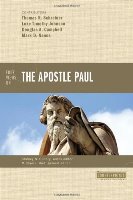About the Editors:
Michael F. Bird (PhD, University of Queensland) is lecturer in theology at Ridley Melbourne College of Mission and Ministry in Melbourne, Australia.
Stanley N. Gundry (Series Editor) is executive vice president and editor-in-chief for the Zondervan Corporation.
About the Contributors:
Thomas R. Schreiner (PhD, Fuller Theological Seminary) is James Buchanan Harrison Professor of New Testament and associate dean of Scripture and interpretation at The Southern Baptist Theological Seminary in Louisville, Kentucky.
Luke Timothy Johnson (Ph.D., Yale) is the R.W. Woodruff Professor of New Testament and Christian Origins at Candler School of Theology at Emory University.
Douglas Campbell is a New Testament professor at Duke Divinity School.
Mark D. Nanos is Soebbing Distinguished Scholar-in-Residence, Rockhurst University.
Overview
This book it highlights four distinct ways of reading the Apostle Paul, each view by an author sympathetic to that view, and each with interaction from the other three views. The four views included are: Reformed, Catholic, “Post-New Perspective,” and Jewish.
Table of Contents
1. Paul: A Reformed Reading
(Thomas R. Schreiner)
Responses
2. The Paul of the Letters: A Catholic Perspective
(Luke Timothy Johnson)
Responses
3. Christ and the Church in Paul: A “Post-New Perspective”Account
(Douglas A. Campbell)
Responses
4. A Jewish View
(Mark D. Nanos)
Responses
Summary
1. Paul: A Reformed Reading
(Thomas R. Schreiner)
Schreiner sets out to sketch Paul’s view of Jesus Christ, salvation, and the church by working inductively from his thirteen letters. This means reading Paul historically in the context of the Old Testament, his primary context, and also Hellenism, a wider cultural context. His belief that Jesus was the Messiah as well as the new way he read the Old Testament (OT) arose from his encounter on the Damascus Road. For Paul, the full significance of the OT can only be understood as it is fulfilled in Christ; indeed, some things were unclear – “mysteries” – until they were revealed in Christ. “Prophecy and fulfillment and mystery and revelation must be correlated and held in tension when articulating Paul’s understanding of the Old Testament.”
This fulfillment of the OT in Christ includes the following: …
[To continue reading this summary, please see below....]The remainder of this article is premium content. Become a member to continue reading.
Already have an account? Sign In
